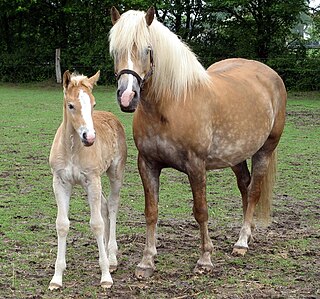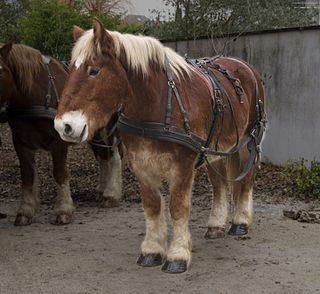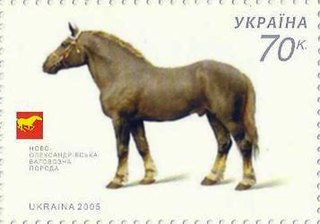
A draft horse (US), draught horse (UK) or dray horse, less often called a carthorse, work horse or heavy horse, is a large horse bred to be a working animal doing hard tasks such as plowing and other farm labor. There are a number of breeds, with varying characteristics, but all share common traits of strength, patience, and a docile temperament which made them indispensable to generations of pre-industrial farmers.

The Clydesdale is a Scottish breed of draught horse. It is named for its area of origin, the Clydesdale or valley of the River Clyde, much of which is within the county of Lanarkshire.

The Percheron is a breed of draft horse that originated in the Huisne river valley in western France, part of the former Perche province, from which the breed takes its name. Usually gray or black in color, Percherons are well-muscled, and known for their intelligence and willingness to work. Although their exact origins are unknown, the ancestors of the breed were present in the valley by the 17th century. They are believed to descend from war horses. Over time, they began to be used for pulling stagecoaches; and later, for agriculture and hauling heavy goods. In the late 18th and early 19th centuries, Arabian blood was added to the breed. Exports of Percherons from France rose exponentially in the late 19th century, and the first purely Percheron stud book was created in France in 1893.

The Dole Gudbrandsdal, Dølahest, or Dole is a draft- and harness-type horse from Norway. The Dole Trotter is alternately considered a subtype of the Dole Gudbrandsdal and a separate breed; it is also considered a part of the coldblood trotter type. The Dole Gudbrandsdal is a small draft horse, known for its pulling power and agility, while the Dole Trotter is a smaller, faster horse used for harness racing; the two types are commonly interbred. Both types are strictly critiqued before entry into the studbook, which has over time resulted in an improvement in the breed type. The Dole is originally from the Gudbrandsdal Valley, and is probably descended in part from the Friesian horse. Over time, the breed has had Thoroughbred, Arabian, and other breeds added in, especially during the creation of the Dole Trotter in the 19th century. The first studbook was created in 1941, and the current breed association was formed in 1947. Although originally used mainly as a pack horse, today, the heavier Dole type is used mainly for agricultural purposes. The Dole Gudbrandsdal been crossed with other breeds to develop horses for harness racing and riding.

The Ardennais or Ardennes is one of the oldest breeds of draft horse, and originates from the Ardennes area in Belgium, Luxembourg, and France. They are heavy-boned with thick legs and are used for draft work.

The Haflinger, also known as the Avelignese, is a breed of horse developed in Austria and northern Italy during the late 19th century. Haflinger horses are relatively small, are always chestnut with flaxen mane and tail, have distinctive gaits described as energetic but smooth, and are well-muscled yet elegant. The breed traces its ancestry to the Middle Ages; several theories for its origin exist. Haflingers, developed for use in mountainous terrain, are known for their hardiness. Their current conformation and appearance are the result of infusions of bloodlines from Arabian and various European breeds into the original native Tyrolean ponies. The foundation sire, 249 Folie, was born in 1874; by 1904, the first breeders' cooperative was formed. All Haflingers can trace their lineage back to Folie through one of seven bloodlines. World Wars I and II, as well as the Great Depression, had a detrimental effect on the breed, and lower-quality animals were used at times to save the breed from extinction. During World War II, breeders focused on horses that were shorter and more draft-like, favored by the military for use as packhorses. The emphasis after the war shifted toward animals of increased refinement and height.

The Irish Draught horse is the national horse breed of Ireland which developed primarily for farm use. Today, they are especially popular for crossing with Thoroughbreds and warmbloods, producing the popular Irish Sport Horses which excel at the highest levels of eventing and show jumping.

The Trait Breton is a French breed of draught horse. It originated in Brittany, in north-west France, from cross-breeding of local horses with various other breeds. It is strong and muscular, and often has a chestnut coat.

The Auxois is a horse breed from eastern France. It is a large breed, with some individuals weighing over 910 kilograms (2,010 lb), bred for horse meat, agricultural work and leisure pursuits. Overall, members of the breed are solid and muscular in appearance. They are usually bay or bay roan in color, although some other colors are accepted by the breed registry, and are known for their power and docility.

The Jutland horse is a draft horse breed originating in Denmark, named after the Jutland Peninsula which forms the western part of the country. Usually chestnut, they are a compact, muscular breed known for their calm and willing temperament. The breed was originally developed for use in agriculture, but today is more often seen in urban settings and at horse shows. Some of the best known members of the breed pull beer wagons for the Carlsberg brewery around Copenhagen, as well as at competitions and for demonstrations. Images from the 9th century show a horse similar to the Jutland being used by Viking raiders in what is now Great Britain. The first written record is from the 12th century, when they were popular as war horses. Some infusion of bloodlines from other breeds occurred in the 18th century, but the modern Jutland type only began about 1850 with the addition of blood from several other breeds, mainly draft horses. A stud book was created in the late 19th century, and the Jutland population grew to a maximum around 15,000 by 1950. Numbers subsequently declined, and as of 2011, only an estimated 1,000 horses remained.

The Soviet Heavy Draft is a Russian breed of heavy draft horse. It derives from the Belgian Brabant heavy draft breed. It was developed in the former Soviet Union for agricultural draft work, and was recognized as a breed in 1952. It is one of several heavy draft breeds developed in the Soviet Union in the twentieth century, others being the Russian Heavy Draft – which derived mainly from the Ardennais – and the Vladimir Heavy Draft, which was derived principally from the Clydesdale.

The Trait du Nord, previously also known as Ardennais du Nord or Ardennais de type Nord, is a breed of heavy draft horse developed and bred in the area of Hainaut in western Belgium and in northeastern France. Originally considered a subtype of the Ardennes, it was recognized as an individual breed with the opening of a studbook in 1903. Developed in the fertile Flemish grasslands, it was bred for size and pulling power for agricultural work. By 1855, the horses bred near Hainaut were considered by some veterinarians to be superior to other Flemish draft breeds. The Trait du Nord was used extensively in mining from the late 19th century through 1920, with lesser use continuing through the 1960s.

The Italian Heavy Draft, or Rapid Heavy Draft, is a breed of draft horse from Italy. The full Italian name of the breed is Cavallo Agricolo Italiano da Tiro Pesante Rapido, "Italian Rapid Heavy Draft Farm Horse", and the abbreviation TPR ) is often used.
The Estonian Draft or Eston-Arden is a breed of draft horse developed in Estonia. They were developed from a cross of Estonian Native horses and Swedish Ardennes and officially recognized by the Estonian government in 1953. Population numbers have decreased since the early 1990s and today inbreeding is of significant concern and the breed is considered to be endangered by the Estonian government. Although originally used for heavy draft work, they are now used mainly for small-scale gardening.

The Australian Draught is a hardy Australian breed of draught horse, noted for its strength and a good temperament.

The Norman Cob or Cob Normand is a breed of light draught horse that originated in the region of Normandy in northern France. It is of medium size, with a range of heights and weights, due to selective breeding for a wide range of uses. Its conformation is similar to a robust Thoroughbred, and it more closely resembles a Thoroughbred cross than other French draught breeds. The breed is known for its lively, long-striding trot. Common colours include chestnut, bay and seal brown. There are three general subsets within the breed: horses used under saddle, those used in harness, and those destined for meat production. It is popular for recreational and competitive driving, representing France internationally in the latter, and is also used for several riding disciplines.

The Croatian Coldblood is an autochthonous medium-heavy horse breed of draught horse originating from Croatia.

The Bruna dels Pirineus, Spanish: 'Bruna de los Pirineos', is a breed of cattle from the south-eastern Pyrenees, in the northern part of Catalonia. It derives from cross-breeding of local cattle with Swiss Braunvieh stock imported in the nineteenth century through France and through the Val d'Aran. It is distributed throughout the northern comarcas of Catalonia, Alta Ribagorça, Alt Urgell, Berguedà, Cerdanya, Pallars Jussà, Pallars Sobirà, Ripollès, Solsonès and Val d'Aran. The Bruna dels Pirineus constitutes about 80% of the beef herd of Catalonia.

The Novoolexandrian Draught is a Ukrainian breed of draught horse. It is named for the state stud farm of Novo-Oleksandrivka in Bilovodsk Raion of Luhansk Oblast in the easternmost part of Ukraine, where it was bred. It shares its early history with the Russian Heavy Draught bred in Imperial Russia in the second half of the nineteenth century, and until after the Russian Revolution known as the Russian Ardennes; later development took place in Ukraine, where it received official recognition in 1999. It was bred for draught work, but it is also reared for meat and particularly for mare's milk, of which it is a high-yielding producer.

The New Altai, also known as Charysh Altai and Chara Altai, is a Russian breed of meat horse. Created by Soviet zootechnicians for breeding in Russia's Altai region, it is more or less closely related to the draft horse, its selection focusing on increasing its meat weight without losing hardiness. Although its origins date back to the 1920s, the breed was truly selected from 1978 onwards, before becoming official in 2000.



















